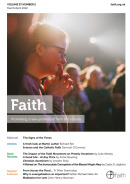Book Review: Grace through Mary's hands
Grace through Mary’s hands
A Retreat on The Immaculate Conception of the Blessed Virgin Mary, Cadoc D. Leighton, OPraem., Gracewing, 42pp, £3.50, $4.95 USA
Review by Sr Mary Dominic Pitts
In reading this series of conferences, the reader of Father Cadoc Leighton’s A Retreat on The Immaculate Conception of the Blessed Virgin Mary becomes a participant in this most unusual retreat, given to the Norbertines of Saint Philip’s Priory, Chelmsford, Essex. In this book, the use of the present tense and of the first person “we” and “I” in the transcription preserves for the reader what was heard by the canons who made the retreat. Indeed, this small book, a transcription of Father Cadoc’s own notes, is declared in the Forward by the abbot to be “one of the best community retreats we have experienced” (ix).
Sin and its remedy
The theme of the four conferences is the triumph over the catastrophe of Original Sin by a Virgin who never, even at her conception, knew sin. The 1854 Apostolic Constitution of Pope Pius IX, Ineffabilis Deus, promulgated the doctrine thus: “By a special grace and privilege of God, in view of the merits of Jesus Christ, the Savior of the human race, [she was] preserved free from all stain of original sin.” The Lord has created the Blessed Virgin Mary sinless with the radiant power of divine innocence, “as terrible as an army with banners” (Song of Songs 6:10) and sends her to a world that “has no notion of evil” nor of “the power of sin to destroy” (13-14). Her purity confounds the ancient enemy.
The second conference is particularly focused on the evil of sin — that it was not only external due to the Fall, but, as missionaries tried to convince pagan converts, “was at work within them, and with which they, fallen human beings, willfully cooperated,” as if helpless to prevent the contagion due to a weak immune system (14). Therefore the retreat turns in the fourth conference to the remedy for sin, the Immaculate Conception, “both the doctrine and the person.” The doctrine has been defined and clarified in its majestic declaration of 1854. “The clarification of doctrine is always an occasion for grace,” Father Cadoc tells his retreatants, and this particular clarification would establish the “triumph of Mary in the world with an act of dedication to her” (5).
Definition and devotion
A definition is an infallible statement on faith or morals. Better known as Papal Infallibility, it declares that in a certain theological area, the Church has understood more of the Revelation in Christ than previously and declares the doctrine to the Universal Church to be believed. Because “knowledge of Christ and Mary go together with love of them” (5), the retreatant and indeed the whole Church will respond with increased devotion to Mary. The retreat is like a personal microcosm of the world so in need of the understanding of sin and the triumph over it.
The Immaculate Conception has traditionally been seen as the “fitting preparation for the Incarnation” (23). Father Cadoc acknowledges this theology of the fitness of her immaculate womb to house the baby who is the Incarnate Son of God. However, Mary is the fitting Mother not merely as the spotless womb for the Son’s conception, but because of her realization of Revelation, her “willing consent to the Incarnation” for which free response she had been prepared by God. Father Cadoc devotes page after page, from the first conference onward, to the healing of the whole world: through the merits of her Son, Mary will restore sanctifying grace. She will anticipate the triumph over evil “by virtue of the Passion and Death of the Lord” (15).
Gateway and foundation
Metaphors abound in the third conference as Father Cadoc uses various images of Mary’s being the gateway to the entirety of Christian Revelation. The Immaculate Conception is not merely a “pretty dawn” but the full daylight of redemption” (22), “the fountain from which the other mysteries of our Faith flow” (24). The Oratorian Father Frederick Faber, quoted several times, holds that “the Immaculate Conception is the foundation of all the other mysteries of Jesus and Mary, and of the Church, and of the Seven Sacraments” (23). “In the Immaculate Conception,” concludes Father Cadoc, “we have, as it were, come in at the entrance and seen in outline the plan of the whole structure” (24).
The likeness of Mary to Jesus
A concept that Father Cadoc uses as connected with the Immaculate Conception is similitude, the likeness of Mary to Jesus. Father Faber again comes to our aid: “[the Immaculate Conception is] the primary revelation of Mary’s similitude to Jesus, because in this she received the fullness of grace that made it possible, indeed, partly accomplished” (25). There are many aspects of similitude to Christ for which we hope, but Mary, our model, is most like her Son in His struggle against evil, against sin… [Her] struggle was far more extreme than ours… It was so much more intense for Mary, precisely by virtue of her Immaculate Conception: she was always aware of the true horror of sin. Her own closeness to God, springing from her deliverance from Original Sin, and her actual sinlessness, allow her always to perceive clearly the terrifying nature of the sin around her… and so we learn courage from her in facing evil. (25)
Thus the Immaculate Conception, newly revealed in its definition, is an invitation to man to know the Son of Mary better in her anticipatory transmission of his merit to her sinlessness. To the extent that we know this astonishing doctrine and love the Mother of God for it, we realize that the Mother of God has loved us in return. She sees even our weak attempts at external veneration as pleas for her grace, and she gives that grace to us in a flood, “a petition for an outpouring of divine grace, given through Mary’s own hands” (6).
Sister Mary Dominic Pitts, O.P., is a Dominican Sister of the Congregation of Saint Cecilia in Nashville, Tennessee.






